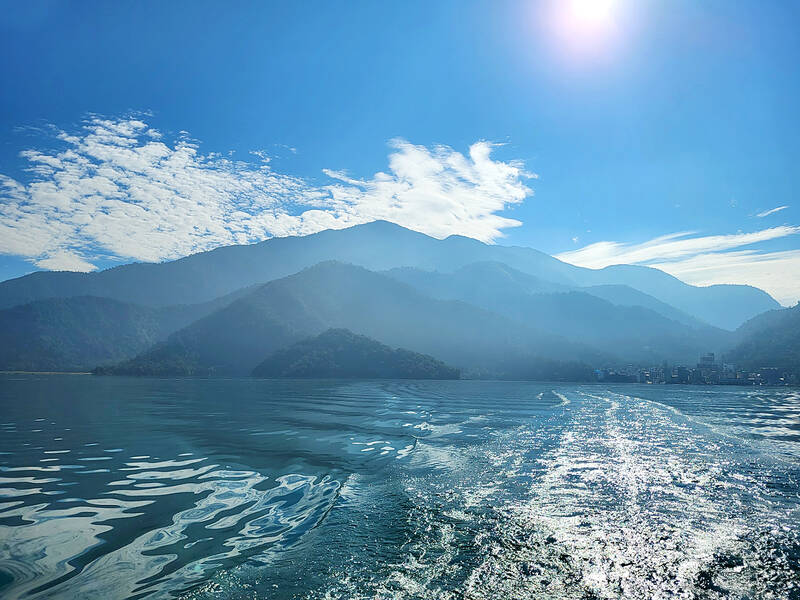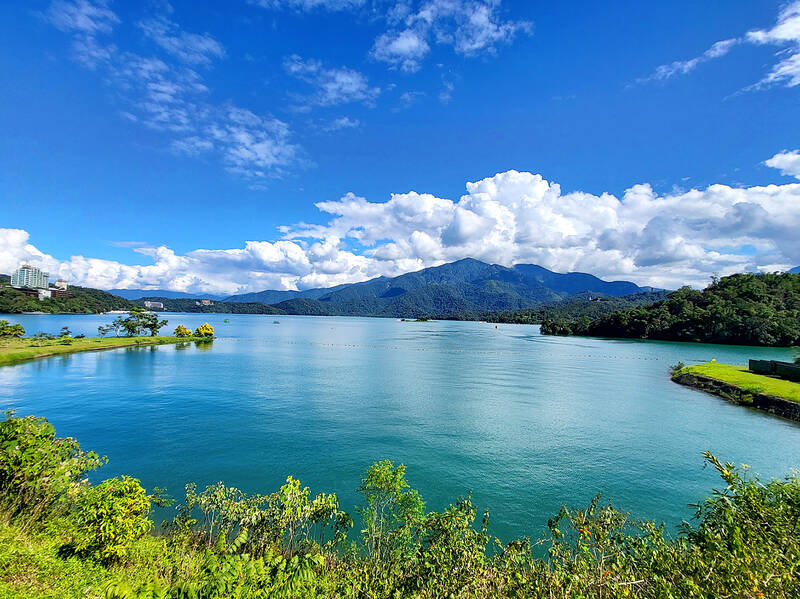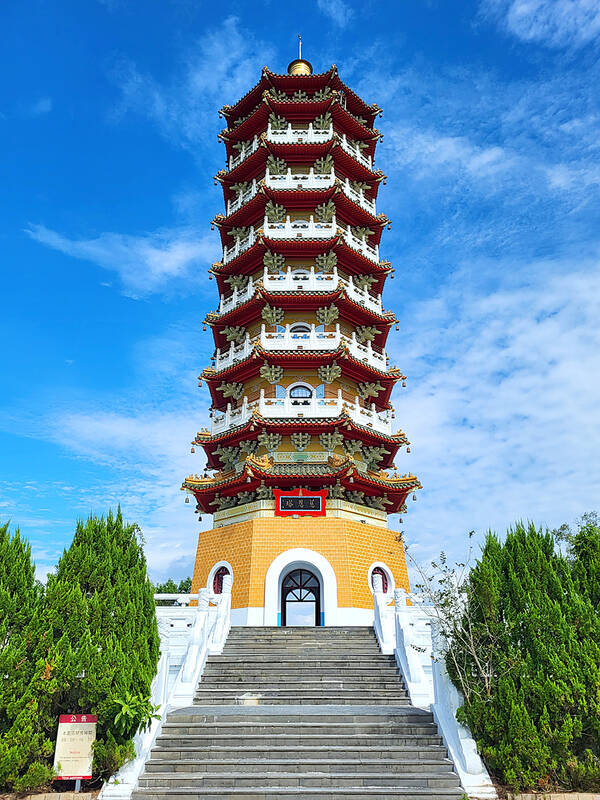Surrounding Sun Moon Lake (日月潭) there are a multitude of activities suitable for all the family that can be enjoyed on a day or weekend trip. On a recent visit, I hiked to a peak, rode a ferry across its emerald waters and a visited a pagoda with outstanding views.
Located in Nantou County’s Yuchi Township (魚池) at 748m above sea level, Sun Moon Lake it is an excellent destination in summer or winter with a year-round moderate temperature.
The lake is the largest body of water in Taiwan with a circumference of 27 kilometers. The east side of the lake resembles a sun while the west side resembles a moon — hence the name.

Photo courtesy of Mark Roche
MOUNTAIN HIGH
The lake and its surrounding countryside have been designated one of the thirteen national scenic areas in Taiwan. On a recent trip I enjoyed a walk along the Maolan Mountain Hiking Trail (貓囒山步道), which is located at the northern edge of the lake and rises to an elevation of 1,020 meters.
The Japanese colonial government established the Maolan Mountain Tea Research and Extension Station here in 1936, mainly to carry out the improvement of growing leaves for black tea.

Photo courtesy of Mark Roche
On the right side of the entrance to the trail there are several old Japanese-style buildings that houses employees for the tea research station that are made with cypress with the inside walls being of bamboo. They have been designated by the county government as an historic site.
The trees alongside the trail are Ceylon olive elaeocatpus, so-named because they are native to Sri Lanka (formerly Ceylon) and India and have fruit that resembles the olive. They are evergreen trees and the red leaves turn fiery red in the fall and winter and, when they fall, pave the ground with a red carpet that makes this a favorite place for taking wedding pictures.
The hike to the peak of the mountain, all on paved road, only takes an hour and is well worth the effort for the spectacular views of the whole area. The warm sunrise illuminates the tranquil lake water and the tea plantation that covers the mountainside, showing another side of the lake’s beauty. There is a weather station on top, which is one of the four highest in Taiwan.

Photo courtesy of Mark Roche
Maolan Mountain is also No. 49 of the Xiaobaiyue (小百岳) or “Small 100 Peaks” — specially selected “suburban mountains” that are more accessible in Taiwan’s cities and counties.
CRUISING THE LAKE
A visit to the lake wouldn’t be complete without enjoying the ferry service across it that connects the main tourist area piers of Shueishe (水社碼頭), Itathao (伊達邵碼頭) and Hsuanguang (玄光碼頭). This service, which triangulates between the three piers runs from 9am to 5pm daily and costs NT$30. Both Shueishe and Itathao have an abundance of guest houses and restaurants and either of these locations is ideal for an overnight stay.

Photo courtesy of Mark Roche
Taking the ferry across allows visitors to fully appreciate what a substantial body of water the lake is — the furthest points between the two main piers is nearly 3 kilometers in distance.
Although I didn’t do so on this occasion I would highly recommend renting a bike to enjoy the bike path that circles the lake. There is a Giant bicycle service station located at the Shueishe Pier. Rentals are reasonable and start at NT$200 per hour (e-bikes are also available).
PAGODA IN THE CLOUDS
One final place to visit is the Cien Pagoda, (慈恩塔), located just a few kilometers from either Itathao or Hsuanguang. Former president Chiang Kai-Shek (蔣介石) had it built in 1971 in an imposing traditional Chinese style in memory of his mother. The bamboo forest lining the route to the gardens at the top is the picture of tranquility.
The building in front of the pagoda was used as a rest house by Chiang and became one of his favorite places to visit.
The pagoda is 46 meters in height and sits on the 954 meter-high Shabalan Mountain (沙巴蘭山) bringing its top to an even 1,000 meters above sea level. The pagoda is an octagonal building; the three floors at the base are painted in white, while the nine floors of the main body are painted in golden red.
The view from the top offers spectacular views of Sun Moon Lake and the surrounding mountains.
Regardless of age, fitness or interests there is something for all the family to enjoy at the lake for a night or two and be sure of finish off your day at one of the many coffee shops or sipping a beer with a lake-side view.

June 9 to June 15 A photo of two men riding trendy high-wheel Penny-Farthing bicycles past a Qing Dynasty gate aptly captures the essence of Taipei in 1897 — a newly colonized city on the cusp of great change. The Japanese began making significant modifications to the cityscape in 1899, tearing down Qing-era structures, widening boulevards and installing Western-style infrastructure and buildings. The photographer, Minosuke Imamura, only spent a year in Taiwan as a cartographer for the governor-general’s office, but he left behind a treasure trove of 130 images showing life at the onset of Japanese rule, spanning July 1897 to

One of the most important gripes that Taiwanese have about the Democratic Progressive Party (DPP) is that it has failed to deliver concretely on higher wages, housing prices and other bread-and-butter issues. The parallel complaint is that the DPP cares only about glamor issues, such as removing markers of Chinese Nationalist Party (KMT) colonialism by renaming them, or what the KMT codes as “de-Sinification.” Once again, as a critical election looms, the DPP is presenting evidence for that charge. The KMT was quick to jump on the recent proposal of the Ministry of the Interior (MOI) to rename roads that symbolize

On the evening of June 1, Control Yuan Secretary-General Lee Chun-yi (李俊俋) apologized and resigned in disgrace. His crime was instructing his driver to use a Control Yuan vehicle to transport his dog to a pet grooming salon. The Control Yuan is the government branch that investigates, audits and impeaches government officials for, among other things, misuse of government funds, so his misuse of a government vehicle was highly inappropriate. If this story were told to anyone living in the golden era of swaggering gangsters, flashy nouveau riche businessmen, and corrupt “black gold” politics of the 1980s and 1990s, they would have laughed.

Imagine being able to visit a museum and examine up close thousand-year-old pottery, revel alone in jewelry from centuries past, or peer inside a Versace bag. Now London’s V&A has launched a revolutionary new exhibition space, where visitors can choose from some 250,000 objects, order something they want to spend time looking at and have it delivered to a room for a private viewing. Most museums have thousands of precious and historic items hidden away in their stores, which the public never gets to see or enjoy. But the V&A Storehouse, which opened on May 31 in a converted warehouse, has come up